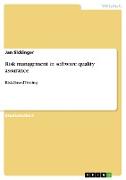- Start
- Risk management in software quality assurance
Risk management in software quality assurance
Angebote / Angebote:
Studienarbeit aus dem Jahr 2010 im Fachbereich BWL - Unternehmensführung, Management, Organisation, Note: 2, 0, FOM Essen, Hochschule für Oekonomie & Management gemeinnützige GmbH, Hochschulleitung Essen früher Fachhochschule, Veranstaltung: Risk & Contract Management, Sprache: Deutsch, Abstract: In general, risk can be expressed as product of amount of damage and probability of
damage. Due to the fact that software controls more and more aspects of life in modern
industrialised societies, software failures inherit risks for businesses, human health or
even human life. Software testing is a structured approach to minimise product risks of
software systems. When the problem arises that, due to a given budget and timeframe, it
is not possible to cover all parts of the software through testing, Risk-Based Testing is a
possibility to test the most critical parts of the software first or more intensive. When
using this method, both amount of damage and probability of damage must be
quantified. Quantifying the amount of damage must happen by considering the different
viewpoints of the software system's stakeholders, while quantifying the probability of
damage can only happen indirectly, for example through quality indicators like the
complexity of the software itself, the quality of the documentation etc. When having
derived quantitative values both for the amount of damage and the probability of
damage, the priority of the test cases can be determined by using a risk matrix.
Furthermore, these values can also be used for metrics.
An extension of Risk-Based Testing is Risk and Requirement-Based Testing, where
product risks are linked to the requirements against which the software is tested in order
to gain an overview if the lists of requirements and risks defined for the software are
complete.
Folgt in ca. 10 Arbeitstagen

